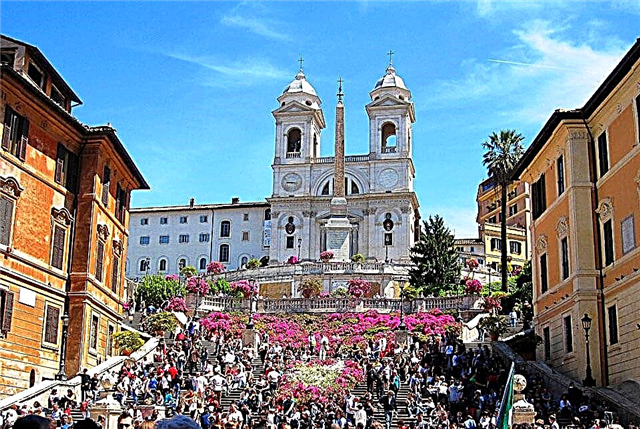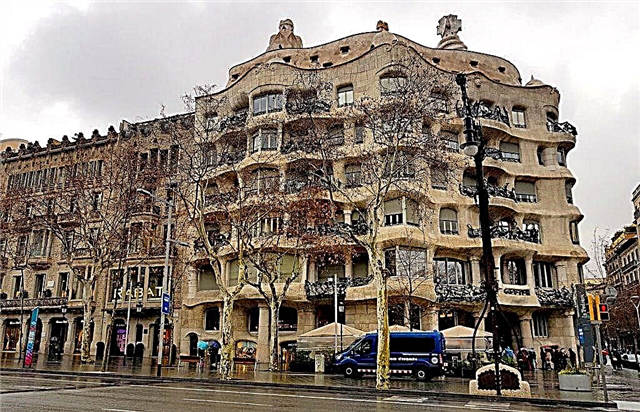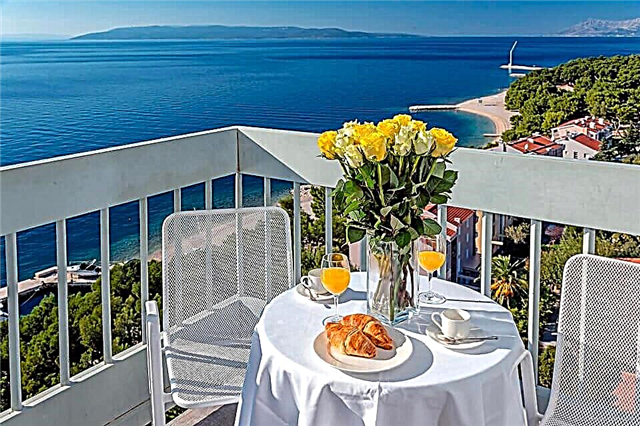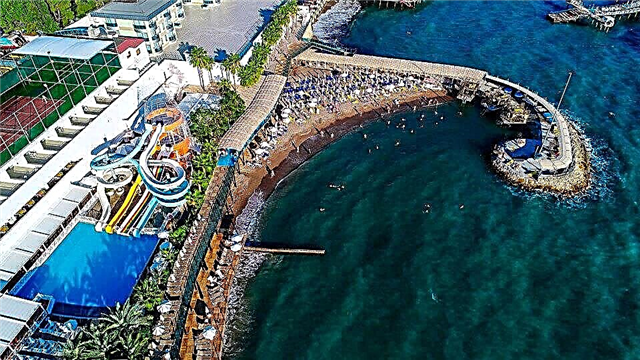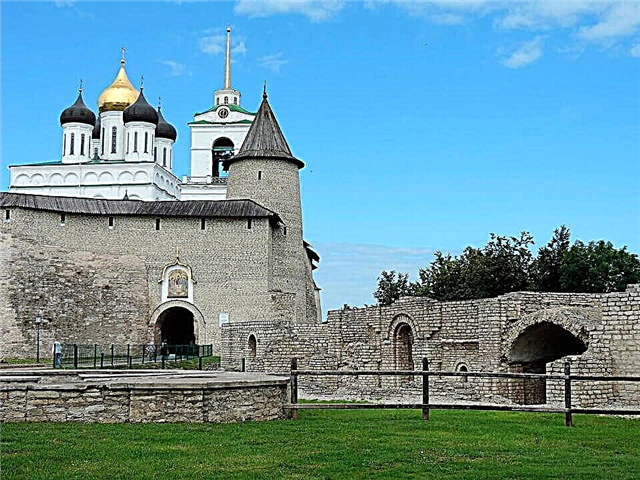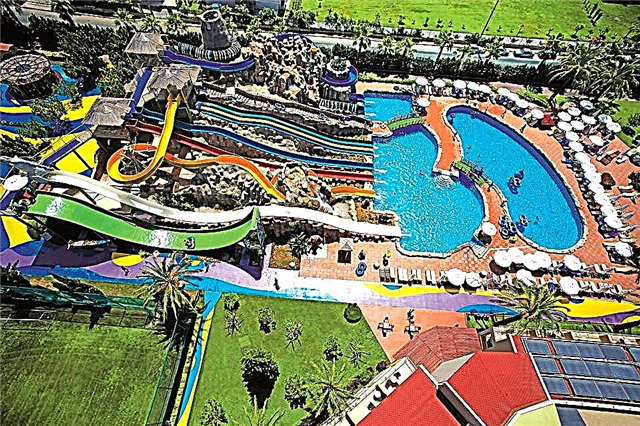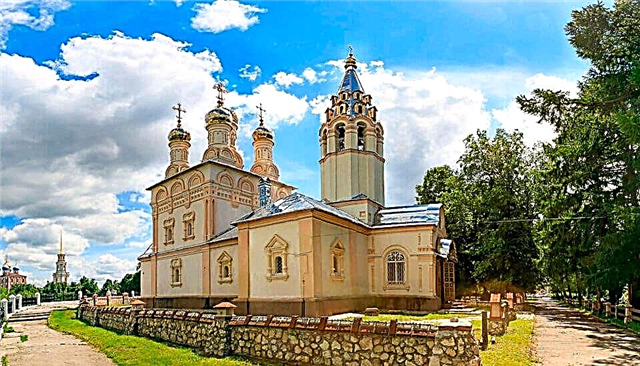Ryazan is one of the oldest cities in Central Russia. As the capital of the principality of the same name, which officially became part of the Russian state only in the 16th century, it developed and lived according to its own scenario. History is full of tragic events and dizzying rises, the memory of which is kept in museums and architectural monuments. In addition, the name of S.A. is inextricably linked with this city. Yesenin, who sincerely loved his small homeland. There are a lot of sights here and it is simply impossible to see them in one day, on your own or with an excursion. But nevertheless, if you draw up the route correctly, then it is quite possible to get an idea of the city, its past and present. We will tell you what you can see in Ryazan in 1 day on your own.
Ryazan Kremlin
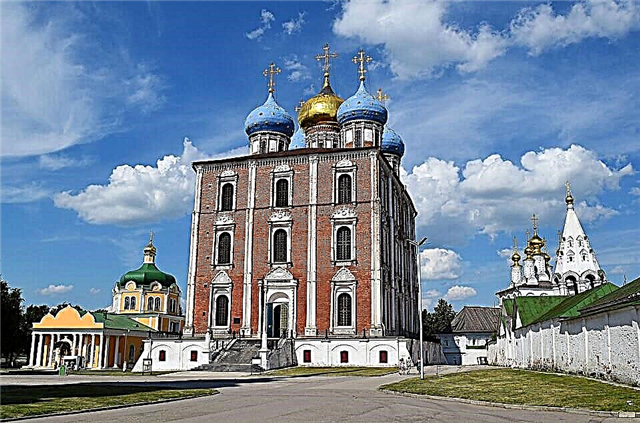
The Kremlin is the historical and actual center of the city, its soul and heart. This is a visiting card of the city, its main attraction. And it is from here that you need to start your walk-acquaintance. Today its territory is a museum-reserve, which includes 18 objects built in the 11-18 centuries.
At the time of its foundation, in 1095, the Kremlin was a wooden fortress surrounded by an earthen rampart (it has survived to this day) and a moat with water. Local peasants and fishermen settled around it. Stone construction began quite late in the city. The first, in the 16th century, was the Gleb Tower. The architectural dominant of the Kremlin is the Assumption Cathedral. The oldest building is considered to be another cathedral, Nativity of Christ. Also interesting is Oleg's Palace - a civil building in which bishops lived for a long time.
It is located at the Kremlin, building 15. You can reach it by any public transport that follows to the Sobornaya square stop. Doors for visitors are open on any day except Monday from 10-00 to 18-00. There are 6 expositions on the territory of the Kremlin, the entrance ticket to each is paid separately and costs from 50 to 130 rubles. One will cost 315.
Nativity of Christ Cathedral

Nativity of Christ Cathedral is the oldest building in the Kremlin. The approximate date of its foundation is 1483. True, then he was called differently - Ouspensky. It was renamed in 1680, after another huge temple was built nearby and the "central" status passed to it. Initially, the cathedral was built not only as a religious center, but also as a burial vault for princes and their wives. Unfortunately, in the 18th century the vault collapsed and the tombs were destroyed. After the restoration, the tradition resumed, but now the highest ministers of the church were buried here.
It is here that the relics of the main saint of the Ryazan land, Vasily of Ryazan, rest. The Nativity of Christ Cathedral is active. Anyone can look at its interior decoration and frescoes of the 19th century, which were partially restored. True, you will have to "adjust" to the schedule of services - it is posted on a stand near the church.
Spaso-Preobrazhensky monastery

Another attraction of the Kremlin is the active Spaso-Preobrazhensky Monastery. Experts cannot say when its history began. The first official mentions date back to 1522. However, at that time "the Matins of the Evangelism began with the bell of the Transfiguration Monastery." This means that it has already existed for a long time and managed to earn a certain status. Unfortunately, the Soviet times became difficult for the monastery. The cemetery was completely destroyed, where noble Ryazan people were buried for hundreds of years, a beautiful garden was destroyed.
Despite the fact that in 1935 the complex was transferred to the jurisdiction of the district museum, for a long time the premises, even of the central Epiphany Church, were used as residential ones. The restoration began only in 1996. Unfortunately, most of the legacy has been lost. Currently, the monastery is active, so the access of tourists to it is limited. But, nevertheless, everyone can enjoy the magnificent architecture of the ensemble.
Assumption Cathedral

The Assumption Cathedral is the architectural center of the Ryazan Kremlin. Its construction began in 1677 - by this time the old temple had ceased to meet the needs of the townspeople, and he needed an alternative. The work was carried out for quite a long time and was completed in August 1702. The fate of the Assumption Cathedral was not easy. Already in 1703, its middle head was broken by the wind. This was followed by a series of misfortunes. In addition, the political and economic status of the city has changed. By the end of 18, the temple was in such a state that the townspeople were afraid to even walk by. Services were no longer conducted there.
Merchants Gabriel Ryumin and Pyotr Malshin gave him a new life in 1804. Soviet times were also difficult - from a religious Assumption Cathedral turned into an administrative and political center. It housed a variety of government organizations. Currently, the cathedral is active. In the summer, services are held there every day, in winter it is impossible to get inside. And there is something to see there - the eight-tier iconostasis, which miraculously survived to this day, amazes the imagination of even seasoned travelers. But the paintings on the walls, alas, have been lost.
Prince Oleg Palace

The largest civil building on the territory of the Kremlin, which was built in stages over the 18-19 centuries - first, under the leadership of the architect Y.K. Ershov, the first two floors appeared, then G.L. Mazukhin supplemented them with a third. It was built for the bishops - for a long time their cells, house church, household services were located here.
Many are confused by the name of the building. In fact, it has absolutely nothing to do with Prince Oleg, the grandson of Yaroslav the Wise. Unless the coat of arms with his image hung on the facade for a long time. Currently, the premises of the palace house an interesting exposition From Russia to Russia, as well as exhibitions Old Ryazan and the Legend of Evpatiy Kolovrat. The entrance ticket costs 130 rubles. Opening hours are the same as for the entire Kremlin - from Tuesday to Sunday from 10-00 to 18-00.
Glebov Bridge and Cathedral Bell Tower

Glebov Bridge is another reminder of the affairs of bygone days. Today it simply connects the territory of Cathedral Park with the Kremlin, but once its purpose was much more serious. For hundreds of years, the bridge has successfully performed a defensive function - during sieges, the crossing was raised, thereby blocking the enemy's path to the Kremlin walls. The exact date of the construction of the bridge is unknown, just as it remains a mystery how many times it was reconstructed.
Much more is known about the Cathedral Bell Tower, the "Ryazan skyscraper". Its construction began in 1797 and ended only in 1840. During this time, three architects were replaced, but despite this, the building in the classicism style turned out to be very harmonious - some even believe that this bell tower can be called the most beautiful in Russia. The Glebov Bridge is located next to the Kremlin, the Cathedral Bell Tower is on its territory. Therefore, getting to them is not difficult. How long the inspection will take depends only on you.
Cathedral Square

Near the historical center, the Kremlin, is the administrative center - Cathedral Square (at different times it was also called Ilyinskaya and Sovetskaya). The first building was erected here in 1786 - it was the governor's office (now - a shoe factory). True, its architecture has survived only partially. Much later, in the 19th century, the Youth Theater was built.
A new attraction of the Cathedral Square is the monument to Prince Oleg, the creation of the famous modern sculptor Zurab Tsereteli.It was installed in 2007. You can get to Cathedral Square by any bus or trolleybus, the route of which passes through the stop of the same name. It is convenient to combine a walk with a visit to the Kremlin and Cathedral Park.
Cathedral park

The most convenient way to get to Cathedral Park is from Cathedral Square, through the front entrance with columns. Literally one step - and the bustle of the city is left behind, peace and tranquility reign on the territory. The main footpath leads to the Kremlin and the Embankment. If you have time, you can wander along the alleys and discover a lot of interesting things.
One of the attractions of the park is a small chapel with a fountain, built in honor of the 900th anniversary of the city. Next to it is the Church of Elijah the Prophet. In Soviet times, its facade was decorated with a bas-relief of Stalin, and lectures were held inside. Then they wanted to open a registry office here, but in the end the building was transferred to the local diocese. And, of course, you cannot pass by the beautiful Church of the Savior on Yar.
Church of the Savior on Yar

Probably, everyone who decides to walk through the territory of the Kremlin simply cannot fail to notice the Church of the Savior on Yara standing on the edge of a cliff over the Trubezh River. Slender, five-headed, it seems to soar in the air and amazes with its lightness and beauty and serves as an adornment of the Cathedral Park. In addition to its architecture, the Church of the Savior on Yar is interesting because it is the oldest of all the existing ones in the city. The first services were held here in 1626. True, in those days the building was made of wood.
A stone temple appeared on this site in 1695. Unfortunately, not much of the interior of the church has survived - it was almost completely destroyed in Soviet times. The Church of the Savior on Yar is located at 14 Petrov Street, literally 5 minutes walk from the Kremlin. You can visit it completely free of charge. True, it should be borne in mind that the temple is active and services are held in it every day.
Monument to Sergei Yesenin
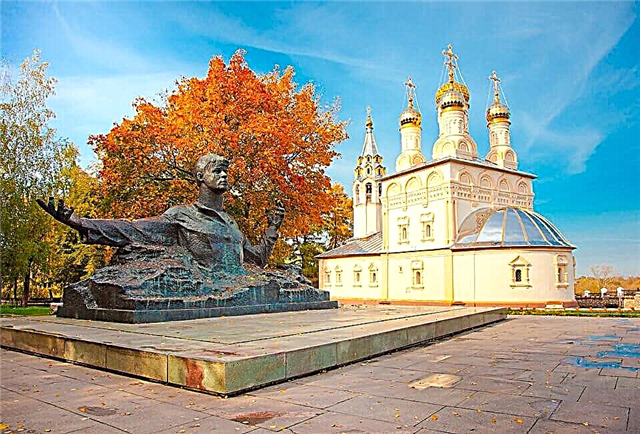
S.A. Yesenin unwittingly became one of the symbols of the city. Which, in general, is not surprising. After all, he loved his small homeland very much, and to this day she reciprocates. On October 2, 1975, the day the poet could celebrate his 80th birthday, a monument in his honor was erected in the center, not far from the Kremlin. To this day, fans of Sergei Alexandrovich's creativity and just tourists often come here.
The monument itself is very unusual. First, the author of the sculpture, Alexander Kibalnikov, placed it not vertically, as is customary, but horizontally. Yesenin himself is like a giant emerging from the earth. The poet's arms are wide open, the collar of his shirt is unbuttoned; of course, he is reading poetry. The place for the installation of the monument, on the bank of the Trubezh River, was not chosen by chance. Firstly, it offers a magnificent view of the surroundings. Secondly. Nearby is a public garden where the poet's favorite birches grow. Inspection of the monument to S. Yesenin can be combined with a visit to the Kremlin - they are very close.
Monument to Evpatiy Kolovrat

Evpatiy Kolovrat is a Russian hero whose courage and strength are legendary. His name is mentioned in "The Tale of the Ruin of Ryazan by Batu" - it was during the Tatar-Mongol invasion that he showed himself as a talented governor and a fearless warrior. Some historians even said that Batu tried to lure Kolovrat to his side, but, of course, unsuccessfully. The memory of the folk hero is immortalized in literature and even modern computer games.
In 2007, a monument was erected in the center in his honor. The construction was carried out entirely with folk funds. The author of the project, Oleg Sedov, managed to talentedly bring his idea to life - the red granite monument symbolizes the earth, and Evpatiy Kolovrat himself looks courageous and majestic on horseback. The monument to the national hero is located in the city center, at the intersection of Pochtovaya Square and Astrakhan Street, literally a 15-minute walk from the Kremlin.
Sculpture "Mushrooms with eyes"

The famous saying that there are mushrooms with eyes in Ryazan is known to many residents of our country. On August 2, 2013, it materialized - a very unusual sculpture appeared on Svoby Street, the authors of which were Vasily and Polina Gorbunov. The opening was timed to coincide with the next birthday of the city. Bronze boletus with a beard quickly became one of Ryazan's tourist brands. And the shop located next to it is a place of meetings and dates.
It is not difficult to find a sculpture - it is located in the Lower City Garden, on Svoboda Street. The nearest stop is the Pavlov Monument. You can get there by trolleybuses # 5, 6, buses # 1, 5, 7, 11, 13, 15, 17, 21, 48, 57 or a minibus.
Museum of the History of the Airborne Forces

Ryazan is traditionally associated not only with the Kremlin and S.A. Yesenin, but also with the airborne troops. First of all, because it is here that the Higher Airborne Command School is located, the history of which began in 1918. Currently, it has its own museum, where everyone can learn about the past and present of the Airborne Forces. Museum workers are former paratroopers, combatants. They are familiar with what they are talking about firsthand, so the excursion turns out to be lively and exciting.
As for the exposition itself, the museum has a fairly large collection of uniforms, parachutes and paratrooper equipment. Those who are not interested in the past of the airborne troops can “flip through the pages” of new history and look into the halls dedicated to Chechnya, Afghanistan, and Yugoslavia. The Airborne Forces Museum is located at 1. Margelova Square. You can get there by any bus or trolleybus that goes to the Detsky Mir stop. Visitors are welcome here every day from 10-00 to 17-00. The cost of the entrance ticket is 80 rubles.
Ryazan Regional Drama Theater

Founded in 1787, it is considered one of the oldest in Russia. True, it was called then differently - the Opera House, and was located in a wooden building. The basis of the troupe was formed by the courtyard and freed young people and girls, and the repertoire was rich and eventful. In addition to them, visiting artists often performed on the stage of the theater. Including world famous ones - Stanislavsky, Chaliapin, Gilyarovsky.
In 1961, a newer building was built for the theater, which has become one of the city's visiting cards. The "citadel of art" is located at Teatralnaya Square, 7-a, in the city center. Nearby there is a public transport stop, which can be reached by many city buses and trolleybuses. The cost of the ticket depends on the performance and the chosen place.
Museum-estate of academician I.P. Pavlova

Ryazan is the birthplace of not only S.A. Yesenin, but also the most famous physiologist in the world, academician I.P. Pavlov. The house with a mezzanine, where he was born and raised, is perfectly preserved to this day. In addition to the house itself, the estate, built in the 19th century, includes a summer gazebo, a bathhouse, an orchard, and a common courtyard. Everything here is very simple and cozy. Sometimes it seems that the door is about to open and the owners will come out to meet. In addition to the typical civil architecture, guests can enjoy an excellent exhibition of over 600 exhibits. Here you can find personal belongings, letters, photographs of Ivan Petrovich. The interiors have also been restored.
The estate museum is located at 25 Pavlova Street. You can get there by bus or trolleybus, which follows through the House of the Artist stop. From Tuesday to Friday, guests are welcome here from 9-00 to 18-00, on Saturday and Sunday from 10-00 to 18-00. Monday is a day off. The cost of the entrance ticket is 100 rubles. Discounts are provided for schoolchildren, students and seniors.
Summer Club of the Nobility Assembly

The history of the wooden house in the city park, decorated with intricate carvings, began in 1901, when the Sobriety Society thought that residents needed a public place to relax. In 1904, a whole complex of summer-type buildings appeared.Theater troupes performed on the stage of the summer club of the noble assembly, showed films, and in winter the stage turned into a skating rink. Nowadays, not much has survived from the complex - only the central pavilion. In which the regional scientific and methodological center of folk art is located.
Tourists are interested in the building exclusively in terms of architecture. The summer club is located in the city park, at 72 Uritskogo Street. The nearest public transport stop is the Art Museum, through which trolleybuses No. 3.10, buses No. 18.23, as well as minibuses pass. The entrance to the park is free.
Starozhilovsky stud farm

The Starozhilovsky stud farm is one of the most interesting sights of Ryazan, which often remains in the shadow of others, more famous. It was founded in the 1890s by order of Baron von Dervies. The architect was Fyodor Shekhtel, an adherent of the Gothic style and a fan of red-brick construction. Initially, the complex consisted of 12 buildings, but only a horse yard, a residential building and a church have survived to this day.
If we talk about horses, then today the number is not too large, about 300 individuals, mainly Russian and Trakehner breeds. The times when Baron von Dervies raised elite Arabian horses for the army, alas, are in the past. In Soviet times, the plant experienced a lot of repression, which led to its decline. The revival began only in the 1990s and continues to this day - difficult and slow. You can learn about the history of the plant by visiting the museum - the guides here really love their job and the story will definitely not be boring.
The Starozhilovsky stud farm is located 50 kilometers from the city, in the village of the same name. You can get to it by suburban bus from the bus station or by train, the nearest station is located five kilometers from Starozhilovo. The entrance to the complex is free. For a nominal fee, you can ride a horse or book an excursion.

